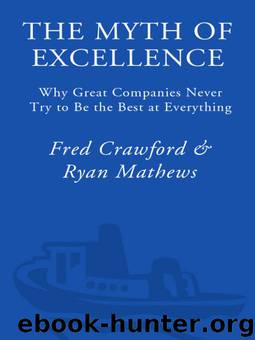The Myth of Excellence: Why Great Companies Never Try to Be the Best at Everything by Fred Crawford & Ryan Mathews

Author:Fred Crawford & Ryan Mathews
Language: eng
Format: mobi
Publisher: The Crown Publishing Group
Published: 2007-12-17T14:00:00+00:00
Applying the Conceptual Model to Access
It’s clear, then, that physical access alone will not be a viable strategy going forward for businesses that choose to dominate or differentiate on access. To succeed, they must take the concept of access to a far higher level. When our conceptual model (Figure 5.1) for Consumer Relevancy is applied to access, here’s what happens:
At the basic threshold of competing on access (Level I), consumers are saying, “Make it easy for me to find what I need, and to get in and out of your store or location in a hurry.” At the level of consumer preference (Level II), consumers are telling businesses to make the experience convenientfor them. At the highest level, in which they actively seek a company (Level III), consumers define access not only in terms of ease and convenience but also in terms of whether that business provides solutions to their lifestyle problems or offers that psychological sense of connectivity and community. For instance, some consumer-direct companies such as Hallmark and Blue Mountain will remind customers about birthdays and anniversaries by sending an e-mail a few days in advance. The companies can then deliver a card or a floral bouquet in time for the special day, thus providing consumers with an easy solution.
Our consumer research helps clarify how this conceptual model of access applies in the real world. For one thing, location placed very low on the list of responses among those related to access, shattering the long-established notion that location is everything. The elements of access that mattered most to consumers exist inside the four walls of a building or inside the computer screen, rather than in the ease of getting there. Brick-and-mortar businesses hoping to compete on access should focus on four key areas: facility cleanliness, price visibility, convenient hours, and facility organization and layout. Two similar factors were considered important for online businesses: clearly stated charges such as shipping (the virtual equivalent of price visibility) and the ability to quickly find what you’re looking for (organization and layout). A third key factor in the wired world was the ability to rely on the company when consumers were in a bind and needed something quickly or unexpectedly.
1. Cleanliness. First and foremost, consumers focus on a facility’s physical appearance: Is it well-maintained and free of trash, clutter, and obstacles such as unpacked boxes, portable shelving, racks of merchandise or literature, ladders, buckets, and items that have fallen off the shelf? Do customers have to go out of their way to find or retrieve an item (such as film, which is often stocked behind the customer-service desk at supermarkets and drugstores)? Accessibility applies to both the physical and the psychological space—particularly in the case of grocery stores and drug and convenience stores, where consumers pointed to a clean, well-maintained store as the aspect of access that they considered most important.
2. Price visibility. The second factor in the access equation is clear and visible prices. Consumers want the prices clearly marked on
Download
This site does not store any files on its server. We only index and link to content provided by other sites. Please contact the content providers to delete copyright contents if any and email us, we'll remove relevant links or contents immediately.
Weapons of Math Destruction by Cathy O'Neil(5833)
Cracking the GRE Premium Edition with 6 Practice Tests, 2015 (Graduate School Test Preparation) by Princeton Review(4049)
What It Really Takes to Get Into Ivy League and Other Highly Selective Colleges by Hughes Chuck(3553)
Fooled by Randomness: The Hidden Role of Chance in Life and in the Markets by Nassim Nicholas Taleb(2861)
The Tyranny of Metrics by Jerry Z. Muller(2849)
The Marketing Plan Handbook: Develop Big-Picture Marketing Plans for Pennies on the Dollar by Robert W. Bly(2797)
Ultralearning by Scott Young(2732)
The Official Guide for GMAT Review 2015 with Online Question Bank and Exclusive Video by Graduate Management Admission Council (GMAC)(2645)
50 Economics Classics by Tom Butler-Bowdon(2413)
The Visual MBA by Jason Barron(1980)
The Inevitable by Kevin Kelly(1835)
Data Science for Business by Foster Provost & Tom Fawcett(1815)
Out of the Crisis by Deming W. Edwards(1760)
GMAT Official Guide 2018 Verbal Review by GMAC (Graduate Management Admission Council)(1705)
Cracking the LSAT, 2012 Edition by Princeton Review(1692)
The Personal MBA: Master the Art of Business by Josh Kaufman(1649)
The Conflict Resolution Phrase Book by Barbara Mitchell & Cornelia Gamlem(1649)
Maths and Stats for Web Analytics and Conversion Optimization by Himanshu Sharma(1565)
College Essays that Made a Difference by Princeton Review(1551)
